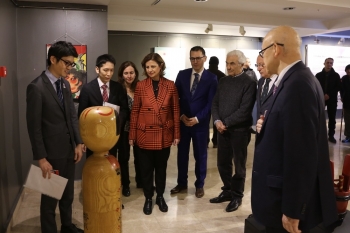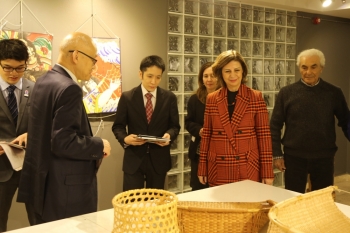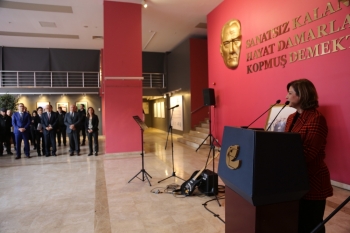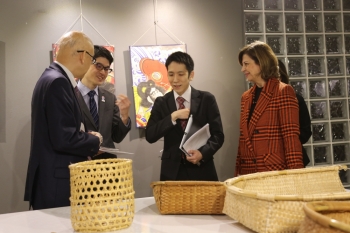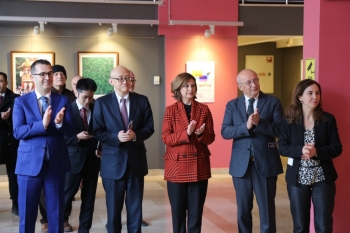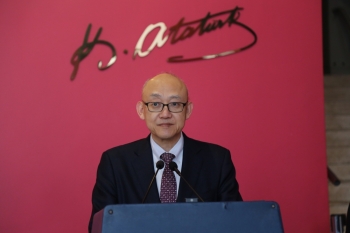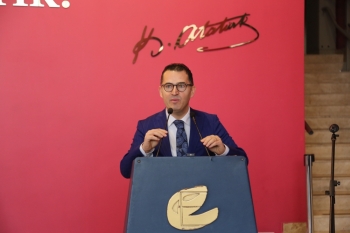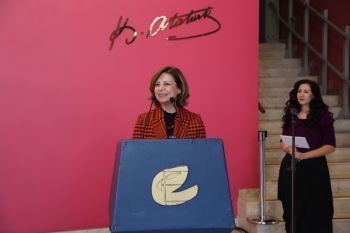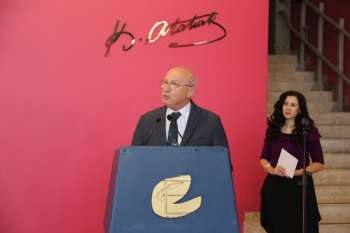06.03.2025
TOHOKU, JAPAN'S FINE HANDICRAFTS" EXHIBITION OPENED WITH A MAGNIFICENT CEREMONY
Eskişehir Metropolitan Municipality and Japan Promotion Foundation are jointly promoting the "Tohoku, Japan's Fine Handicrafts" exhibition. Hosting reflections of Japanese culture, the exhibition will welcome visitors until May 11.
Eskişehir Metropolitan Municipality continues to present art productions of different cultures to art lovers in Eskişehir with an understanding that will set an example for the entire country. This time, the "Tohoku, Japan's Fine Handicrafts" exhibition, hosting reflections of Japanese culture with a history of thousands of years, has opened.
Eskişehir Metropolitan Municipality Mayor Ayşe Ünlüce, Japan's Ankara Embassy Charge d'Affaires Koji Tahara, Deputy Governor Oğuz Şenlik, CHP Member of Parliament Utku Çakırözer and many art lovers attended the exhibition presented at the Atatürk Culture, Arts and Congress Center.
Speaking first at the opening of the exhibition, the chargé d'affaires of the Japanese Embassy in Ankara, Koji Tahara, said, This exhibition was created to commemorate the first anniversary of the great earthquake and tsunami that occurred in the Tohoku region on March 11, 2011. This exhibition, which includes select Tohoku handicrafts, introduces the beauty of ancient handicrafts that have been almost forgotten in modern Japan as civilization has advanced. The exhibition includes works in a wide variety of genres, such as ceramics, lacquer, painting and weaving, metalwork, wood and bamboo handicrafts. I would like to thank all those who contributed, especially Eskişehir Metropolitan Municipality Mayor Ayşe Ünlüce.
Stating that Eskişehir is a city of culture and art, Utku Çakırözer said, Thanks to you, Eskişehir has become a city that truly deserves the title of the cultural capital of Anatolia with its exhibitions, concerts, plays, and museums. It has become a city where we and our citizens coming from other cities of Türkiye have difficulty choosing every week, and where to go. We are very happy about this. I believe that even more cultural and artistic activities will place Eskişehir, Türkiye and the world as a shining star.
Tohoku, Japans Fine Handicrafts exhibition will strengthen the friendship between the two countries, Deputy Governor Oğuz Şenlik said, We are opening a very beautiful exhibition here with the cooperation of the Embassy of Japan and our Metropolitan Municipality. We are together in the exhibition that blends the culture of Japan, increases our unity, togetherness and solidarity and further strengthens the ties between the two countries. I would like to thank everyone who contributed.
Metropolitan Municipality Mayor Ayşe Ünlüce also said, As you know, Eskişehir is an earthquake zone, the city where the exhibition takes place is an earthquake zone and it is an exhibition that was formed with the pains of that earthquake and tsunami in 2011. Therefore, as a country that has experienced these pains a lot and as a city in Eskişehir, which is in an earthquake zone, I find this exhibition very meaningful. It is also valuable in terms of keeping the forgotten handicrafts of Japan alive and introducing them to us. Eskişehir residents were introduced to Japanese culture in the Japanese Garden located in Anadolu University in the old years. Afterwards, the Japanese Garden located in Sazova Park of Eskişehir Metropolitan Municipality was opened. In May, it became a park reflecting the architecture and landscape of Japan with those beautiful trees. The Odunpazarı Modern Museum, an award-winning project prepared by Japanese architect Kengo Kuma and his team, was opened in our city. Therefore, these beautiful and valuable ties between Eskişehir and Japan and the love and respect they feel for each other will be crowned with this exhibition today. We will experience that beautiful unity of the two countries.
Tohoku, Fine Handicrafts of Japan exhibition will be waiting for its visitors at Atatürk Culture, Art and Congress Center until May 11.
EXHIBITION
In the early twentieth century, Soetsu Yanagi, the founder of the Mingei Movement, was amazed by the beauty of local handicrafts while traveling through the Tohoku region of Japan and began collecting objects and tools he found during his visits. Other influential members of the movement, including potters Kanjiro Kawai and Shoji Hamada, textile designer Keisuke Serizawa, and leading woodblock printmaker Shiko Munakata, were also deeply influenced by the handicrafts of the Tohoku region. The handicrafts on display cover a variety of genres, including pottery, lacquerware, textiles, metalwork, and wood and bamboo work. The exhibition also presents works created by artists inspired by the fine craftsmanship of folk crafts and reflecting the cultural climate and spirit of Tohoku.
No cookies that process personal data are used on this website.

